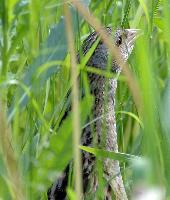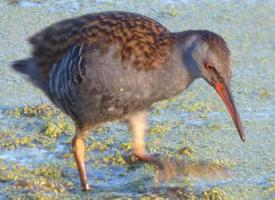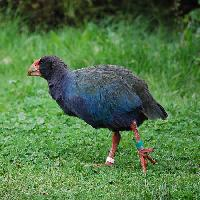
Állatleírás
The Corn Crake (Crex crex) is a fascinating bird species that belongs to the family Rallidae, which includes rails, crakes, coots, and gallinules. This bird is particularly known for its distinctive vocalizations and elusive nature, often heard more than seen. The Corn Crake is a medium-sized bird, measuring about 27-30 cm in length, with a wingspan of approximately 45-53 cm and weighing between 150-200 grams.The physical appearance of the Corn Crake is characterized by its brownish plumage, which serves as excellent camouflage in its natural habitat. The upperparts of the bird are marked with strong black and brown streaks, while the underparts are a lighter greyish color, with variations of buff and white. Notably, the Corn Crake has a striking barred pattern on its flanks and undertail, which adds to its distinctive look. The bird has a short, thick beak, adapted for its omnivorous diet, and strong legs that are well-suited for its life mainly on the ground.
One of the most remarkable aspects of the Corn Crake is its vocalization. The male Corn Crake's call is a loud, repetitive "crex crex," from which its scientific name is derived. This call, often heard during the breeding season at night, serves as a mating call to attract females and as a territorial signal to other males. The sound is surprisingly loud and can carry over long distances, adding to the bird's mystique as it is often heard but remains hidden in dense vegetation.
The Corn Crake is a migratory bird, spending its breeding season in Europe and parts of Asia, in meadows, farmlands, and tall grasslands, where it nests on the ground, hidden among dense vegetation. The breeding season sees the Corn Crake engaging in a monogamous relationship, with the female laying a clutch of 8-12 eggs. After a gestation period of about 19-20 days, the chicks are born precocial, ready to leave the nest shortly after hatching.
During the winter months, the Corn Crake migrates to sub-Saharan Africa, where it lives in similar grassland habitats. This migratory pattern underscores the bird's reliance on specific habitats, which, unfortunately, are under threat due to agricultural practices, land-use changes, and habitat destruction. As a result, the Corn Crake is considered a species of conservation concern in many parts of its range.
Efforts are being made to conserve the Corn Crake and its habitat, including changes in agricultural practices to delay mowing of grasslands until after the breeding season and the creation of protected areas. These conservation measures are crucial for ensuring the survival of this unique and elusive bird, whose presence is a key indicator of healthy grassland ecosystems.
In summary, the Corn Crake is a distinctive bird, both in appearance and behavior, with a fascinating life cycle that spans continents. Its unique vocalizations, migratory patterns, and habitat preferences make it an interesting subject of study for ornithologists and bird enthusiasts alike. However, the Corn Crake's survival is closely tied to the conservation of its natural habitats, making it a symbol of the broader challenges facing biodiversity in the face of changing human landscapes.
Előfordulási térkép

Hasonló állatok
Új állatfotók
Top 10 állat
- Dolphin gull (Leucophaeus scoresbii)
- Diana monkey (Cercopithecus diana)
- Moustached guenon (Cercopithecus cephus)
- Galápagos tortoise (Geochelone nigra complex)
- Japanese macaque (Macaca fuscata)
- Russian tortoise (Testudo horsfieldii)
- Stone loach (Barbatula barbatula)
- Greek tortoise (Testudo graeca)
- Common flying dragon (Draco volans)
- Vendace (Coregonus albula)


